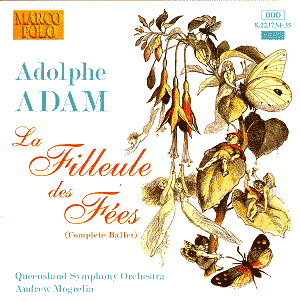Adolphe Adam was born in Paris in 1803, the same year
as Berlioz. Most record collectors will know him as the composer of
the ballet Giselle, but he was very much more than that, being
both a respected teacher and an influential music critic, not to mention
the small matter of the seventy or so operas he composed.
La Filleule des Fées (‘The Fairies’ Goddaughter’)
is a full-length ballet which was first seen at the Paris Opera. It
was apparently quite a success, though the booklet notes draw greater
attention to innovative features of the staging than to the music, which,
even for 1849, was conservative in style and would not have frightened
the horses. It’s interesting to speculate, therefore, quite what he
and Berlioz, whose paths must certainly have crossed on more than one
occasion, thought of each other!
The story begins at the baptism of the child Ysaure
and the appearance at the celebration of three old women, later to be
revealed as three fairies, two good, one bad. These three, as the title
suggests, become Ysaure’s unofficial godmothers, and therefore very
much have a hand in what follows. And what follows is a tale of love
conquering all. Ysaure has two suitors, one of whom is called Alain
and the other the Prince Hugues de Provence. No contest really. In fact
things turn out to be quite difficult, especially since the bad fairy
decides to save her baptismal gift until Ysaure’s fifteenth birthday.
As is the way with wicked fairies the gift turns out to be a mixed blessing:
she makes Ysaure so beautiful that any man who looks at her, including
the Prince, goes mad. One way round this sorry state of affairs is to
strike the Prince blind, but this of course is hardly the ideal solution
either, and so, with the intervention of the good fairies an agreement
is made that if the Prince can recognise Ysaure amongst all the girls
present at a given moment his sight and sense will be restored. Somehow
the different parties contrive to bring the pair so close to each other
that their hearts beat in unison, and the Prince, of course, recognises
her immediately. Who wouldn’t? Prior to this Ysaure has, amongst other
adventures, ridden on a swan and spent a short time as a statue. As
for poor Alain, he seems to lose out to the aristocracy at every turn,
but he’s a decent chap, and when he sees how happy Ysaure and the Prince
are, he is happy in his turn.
A detailed synopsis is printed in the booklet, and
following the story whilst listening to the music is a simple matter.
That said, there’s very little attempt at characterisation, beyond a
certain number of stock gestures to differentiate good from evil, for
example. And then you know there are hunters about even without the
synopsis because you hear their horn calls amid jolly galloping music
in six/eight time. Odd moments of suspense are underlined by chromatic
movement in the bass.
Other composers come to mind from time to time listening
to this music, the Johann Strauss of Die Fledermaus, for example,
or occasionally Rossini, but not, emphatically not, Berlioz! I haven’t
seen a score of this piece, but careful listening reveals little in
the way of thematic development beyond having them played again with
different interludes, sometimes with the orchestration varied, sometimes
not. The orchestral writing is often quite effective, however, in particular
the use of the woodwind. But there are too many grand fanfares to introduce
new dances, and too many big finishes that other composers would be
happy to use at the end of a huge symphony. After a while you get tired
of all those repeated cymbal crashes on strong beats too. The structure
starts to reveal itself after a while, and many of the themes return,
but, as previously stated, without much in the way of development. Nor
are the themes themselves always of enough interest or character to
make us altogether happy to hear them again.
You can certainly see the dance in your mind’s eye
when you listen to this music, and I’m quite sure that as an accompaniment
to dance the music is well crafted. There are passages in all ballets,
and in operas too for that matter, where the emotional temperature is
allowed to drop a little; in Swan Lake or The Sleeping Beauty,
in Ma mère l’Oye or The Prince of the Pagodas.
And this is perfectly natural: the eventfulness of the music must be
geared, after all, to the events it accompanies. But here these passages
are not alleviated by others of outstanding inspiration and beauty as
they are in Tchaikovsky’s masterpieces, for example. And I know we shouldn’t
always compare with the finest examples of a given form. I’m merely
doing so here to underline my own reaction to this music which seems
to me to be particularly bland and uninspired.
There can be no complaints at all about the production
values of this set, however. The booklet is informative and well written,
and the performance itself is excellent. The Queensland Symphony Orchestra
play extremely well under conductor Andrew Mogrelia, but they can only
find in the music what there is in it to find, and the poor second violins
and violas can hardly have had a riveting few days recording this.
Perhaps listeners more attuned to dance than I am will
be able to hear more in this issue than I did. In any case, I urge them
to try it, as the efforts of all concerned should be recognised. I do
wonder, however, if the music justified the effort involved.
William Hedley


![]() See
what else is on offer
See
what else is on offer 